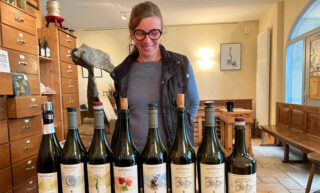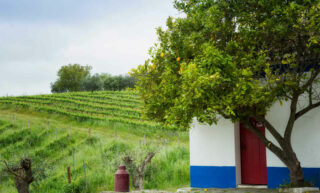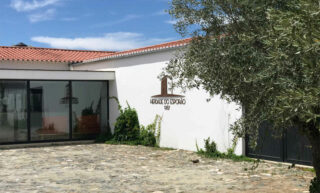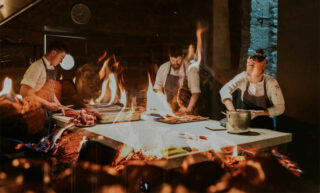Portugal, and certainly the Alentejo, is known for its warm climate and its full-bodied, warm-blooded wines. But due to climate change, the conditions are becoming more and more difficult even for this style of wine. The cooler foothills of the Serra de São Mamede, in the northeastern part of the Alentejo, are attracting a host of new vintners and have become, in more than one way, Portugal’s coolest wine region. But the region's success is not only driven by lower temperatures and a bit more rain.
In many ways the Alentejo is the workhorse of Portugal’s wine production. After the dictatorship ended, winegrowing picked up again and, due to the size of the estates, volume production is the norm. A good price-to-quality ratio is one of its success factors. The sunny, warm weather takes care of easy ripening and serious sugar build-up in the grapes. As a result, the wines are typically big, bold, and packed with ripe fruit.
However, with the summers getting even hotter than they already are – temperatures now routinely hit the 40 degrees Celsius, precipitation decreases, and water is becoming an ever-scarcer commodity – winemakers fear for their future, or at least for that of the next generation.
Abandoned mecca
Turning to heat-loving, late-ripening, often indigenous grape varieties are part of the coping strategy, as well as different vineyard layouts, adjusted canopy management, sustainable farming practices, etc. But on top of all that, a number of wine producers have acquired vineyards in the Serra de São Mamede, a small mountain chain in the northern Alentejan subregion of Portalegre bordering Spain. João Pedro Azevedo Mendes, the general manager at Quinta da Fonte Souto calls it the “new mecca, or actually the abandoned mecca of Portuguese winemaking.” It is home to the highest point (1025 m.a.s.l.) of Portugal below the Tagus and hence is a few degrees cooler and receives up to 350 millimeter more rain per year. Nonetheless, even here climate change is noticeable. As common wisdom has it: “Em Abril, aguas mil.” In other words, April should be a wet month, but when I visited the area in April of this year the weather was sunny and dry. Though the winter had brought plenty of rain, it fell, for a large part, in one big torrential shower on 20 December, which also flooded the Lisbon metro. It drained off quickly through the rivers and creeks rather than replenishing the soils.
Rui Reguinga ©Terrenus winery
The Serra de São Mamede forms the heart of a national park. Protective regulations guarantee (up to a point) that the environment is pristine and healthy. The park authorities also restrict the way the ground is used. Opportunities to buy into the region are therefore limited, and the price for a hectare of vineyard has increased sharply. With the entire sub-appellation of Portalegre currently measuring only 620 hectares (for DOC wines only), it will never be a refuge for the entire Alentejo (around 16.500 hectares for DOC wines plus 5.500 hectares for IGP wines).
Old vines
Until the early 2000s the Serra de São Mamede was more or less off the radar. Apart from some professional wineries that vinified themselves, many of the grapes ended up at the cooperative or in wines for the farmers’ own consumption. As a result, the area escaped much of the EU stimulus to root up old vines and focus on large scale production of the main international varieties. The region therefore still has a huge stock of old vines. These deeply rooted plants need no or very little irrigation, and although their yields may be lower, their concentration is higher – two more reasons why the vineyards here are in high demand.
In the vineyards of Rui Reguinga’s winery Terrenus, for instance, few vines are younger than 30 years. Local varieties like the red Trincadeira, Alfrocheiro and Camarate and the white Arinto, Roupeiro, and Tamarez, are interplanted with varieties from other parts of the country like Baga and Bical (white). The story is that a wandering labor force brought these varieties to the Serra de São Mamede. Even a century ago, finding labor here wasn’t easy.
Revival
Apart from altitude, old vines and traditional varieties, the region also boasts cool granitic soils, and a little bit of limestone, although there is heat accumulating schist too. Moreover, there is an array of exposures, as Reguinga, the region’s trailblazer who arrived here in the early 2000s, shows me when we toured the area in February this year. Standing at 750 m.a.s.l. in his north-facing vinha de Marvão (vinha is Portuguese for vineyard) in the heart of the Serra de São Mamede, a bitingly cold wind cut through my jacket. Across the road, the beautifully terraced vinha da Serra is somewhat protected from the wind and has a slightly warmer climate due to its more westerly exposure. On the valley floor two enclosed vineyards, the clos Ammaia and the clos de Muros, further add to the diversity of Reguinga’s collections of vineyards.
João Afonso
Five years after Reguinga, João Afonso, a former ballet dancer turned wine writer, started his Cabeças de Reguengo winery just outside Portalegre. Both in terms of farming and winemaking, Afonso firmly believes in the wisdom of former generations. His bush vines, for example, are planted in a historic, seemingly random triangular pattern called pe de galinha, or chicken foot, that facilitates airdrying after rainfall, allows more sunshine into the vineyard and still leaves space for (diagonal) ploughing or carrying out other tasks. In the cellar he has a hands-off approach.
Two other vintners, who joined the ranks more recently and are further enriching the vinous fabric of the Serra de São Mamede, need to be mentioned here as well. After some years of buying grapes, Susana Esteban, a Galician winemaker who built her career in Portugal, has established her winery just outside the village of Alegrete. Her fantastic artisanal wines rock the Portuguese wine world and beyond.
Vitor Claro, a former chef, stumbled upon some vineyards in the Serra de São Mamede by chance, but he confirms, just like the others, that the conditions for winemaking are excellent. On his property in Salão Frio he and his wife Rita Ferreira craft an interesting range of natural wines.
Not only the boutique wineries settle in the Serra de São Mamede, but also Portugal’s large estates have found their way to the northern Alentejo. Sogrape, Herdade do Esporão, Dirk van der Niepoort, Herdade de Malhadinha Nova, Herdade dos Grous, and Symington all have an estate or buy grapes here. Their approach may be different; their motivation to come to Serra de São Mamede is the same. Cooler and wetter conditions, old vines, good soils, and traditional varieties are the ingredients of a region with great promise.
For Esporão, a large organic winery in Reguengo de Monsaraz in the southern Alentejo, the area is a source of grapes with good acidity to give their blends a fresh kick. But they also produce a wine, the Monte Velho Altitude, made exclusively from grapes grown at their estate, Lavradores, in the Serra de São Mamede. With Herdade da Fonte Souto, Symington, a conglomerate of around 25 quintas, has a base where they make a range of region-specific wines. Driving with Azevedo Mendes in his pick-up truck around the 207-hectares property with its own dam and two large water tanks where winter rains are collected for irrigation during the summer, it becomes clear why the Serra de São Mamede is so attractive.
Vitor Claro and Rita Ferreira
Although the region is blessed in many ways, it isn’t without challenges. Its shrinking and ageing population makes it hard to find labor, a reason why Fonte Souto plans to switch to machine harvesting. Its remoteness – Portalegre is Portugal’s only district capital without direct access to a highway – makes it relatively hard to reach. Nonetheless, the Serra de São Mamede has developed itself within barely two decades into one of Portugal’s coolest and most sought-after wine regions. When you taste the wines, you will understand why.
TERRENUS
While doing an internship at the cooperative of Portalegre, the district capital, Reguinga became aware of the region’s potential and sought out some good parcels to start his own winery in 2004, thus marking the beginning of the revival of the region. From 12 hectares divided over seven parcels, Rui Reguinga crafts eight wines, four whites and four reds, on average 60.000 bottles per year. In his small adega in Portagem the grapes are fermented in tailor-made stainless-steel tanks, concrete egg or open top wooden fermenters. As a consultant to other wineries, Reguinga has to work with the grapes grown by his clients. At Terrenus, he has control over the entire production. Reguinga favors a relatively hands-off approach to winemaking. One vineyard, the Outeiro Alto, is currently in conversion to organic farming.
The Vinha da Ammaia Amphorae 2021 made from grapes from the eponymous walled vineyard, is a field blend with Malvasia as the dominant variety. For a wine that has seen two months of full skin contact, the color is surprisingly light, golden rather than amber. There are aromas of honey, dried flowers, some chamomile and dried apricots. As the wine is matured in amphora, there are no aromas or flavors of oak. On the palate the wine is dry, has round acidity and, with a pleasantly modest alcohol level of 12% abv, a medium body. A tiny bit of grip from the tannins that leached from the skins (but again less so than you would expect from an orange wine) make this wine a wonderful partner for all sorts of food. A lovely wine and an excellent introduction to skin fermented white wine.
The Clos dos Muros 2016, just like the Ammaia a single vineyard wine, is made from centenarian vines – at around 120 years of age, they are Reguinga’s oldest. A field blend with Grand Noir as the most important component, the grapes are fermented and macerated for six weeks in a wooden fermenter with one daily pushdown. Bottling takes place after two years in 1000-liter barrel. Despite its age, this wine still feels very young: signs of development in the bottle are hard to detect. Deep flavors of black cherries and dark berries, a waft of lilies, and a sprinkling of chocolate rise from the glass. On the palate, these aromas are complimented with light spices and a hint of forest floor. The powdery tannins are exquisite. The tasting experience is one of balance, length and depth, and despite its youthful character, the 2016 vintage is a pleasure to drink.
CABEÇAS de REGUENGO
João Afonso believes in the powers of nature. He can’t say how many vines per hectare he has because his vines are interplanted with olive and fruit trees. He throws away some of the disease affected grapes, rather than using chemicals. Instead, he applies nettle, eucalyptus, fern and comfrey teas to avoid diseases. He doesn’t work the soils and lets the grasses between the vines grow until knee high. Between November and February sheep roam the vineyards as a way of fertilizing the soils. He adheres to a low intervention way of winemaking resulting in pure, fresh, expressive and utterly drinkable wines.
The Solstício 2021, which I tasted from barrel, consists of 50 percent Trincadeira, the remainder includes Grenache, Cinsaut and several other varieties. The wine gets just eight days of maceration. The nose was reminiscent of Gamay, on the palate it was round but structured with plenty of red and dark berries. The bottle of Solstício 2018 that I drank in December paired elegance with power (although the wine had a modest alcohol level of 13% abv). Restrained berry fruit was complemented with subtle spice, kept together by lacy tannins and bright acidity.
João Afonso is a great fan of the red variety Castelão, but he doesn’t like most of the modern style versions of it, with high alcohol and new American oak. For his compelling Castelão (barrel sample) he buys grapes from a winemaking friend in the Setúbal appellation. With just five days of skin maceration, you’d expect a light-colored wine, but its color is actually a medium ruby. There is a bucket full of red plums and red and dark berries balanced by a subtle note of cedary wood, a waft of tar and some spice. The wine has a firm tannin structure underpinned by lively acidity, giving it plenty of ageability. However, its freshness gives it, even in its youth, great attraction. Long finish with a tiny bitter note that keeps the wine interesting to the very end.
QUINTA da FONTE SOUTO
Quinta da Fonte Souto is Symington’s first venture outside the Douro Valley. Apart from their meritorious Florão white and red, the entry level wines, Fonte Souto also produces three mid-price wines (red, white, rosé), a beautiful monovarietal Alfrocheiro, and an intense, dark-fruited blend of Alicante Bouschet and Syrah, the Vinha do Souto. Winemaker Ricardo Constantino successfully retains freshness and keeps the wines digestible despite sometimes (inevitably) highish alcohol levels.
The Alfrocheiro 2019 is Quinta da Fonte Souto’s first monovarietal wine. After handpicking, the grapes were lightly crushed and fermented. After a short period of post-fermentation maceration to extract some more tannins, also from the pips, the wine rests for 11 months in 400-liter oak barrels. It has a rosy, minty nose with fresh notes of dark berries and strawberry and an undertone of flinty minerality with possibly a hint of graphite. The generously available tannins are fine and round; it has a rather full body and lingers long on the palate.
VITOR CLARO
Vitor Claro and his wife Rita Ferreira have a very low-intervention approach to wine. In the vineyard they use only chalk to balance the acidity of the granitic soils, and organic matter to fertilize. To deal with climate change, they are in the process of planting more Moreto, a heat-loving variety from the Southern Alentejo. Claro emphasizes the importance of alcohol in wine. He harvests early, but he doesn’t compromise on ripeness. Claro and Ferreira’s wines are unfiltered, but clean. Only one had a – for me – undesirable funky note.
Claro’s Hortas 2021 red comes from a south-facing plot and is fermented in traditional chestnut barrels. When the fermentation slows down, the grapes are pressed off and partly racked into stainless steel. The barrel sample I tasted had a youthful bluish blush. On the nose it was stony-minerally with cherry and woody-herbal tones. On the palate there was some spice as well. The wine had medium tannins, which were cool and silky but not without some grip, and there was just enough energizing acidity.
SUSANNA ESTEBAN
Tiro o Véu is an amphora wine made from a field blend of local grape varieties. 30 percent of the grapes is added to the ferment, including the skins, giving the wine its beautiful golden color and an elegant texture. Aromas and flavors such as orange, orange peel, blossom, and tarte tatin are complemented by a savory note and highlighted by a streak of salinity. Soft but fresh acidity. Very good to accompany food and a good introduction to skin-contact wines for those who don’t know them or think they don’t like them.
A version of this article has been published on Perswijn‘s website (21 June 2023) and in Apéritif (issue 5/2023) and Vince (04-2024).







Comments